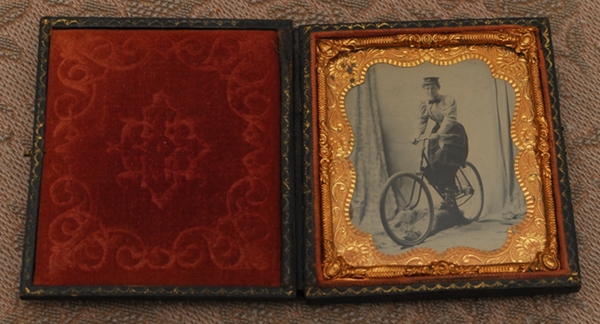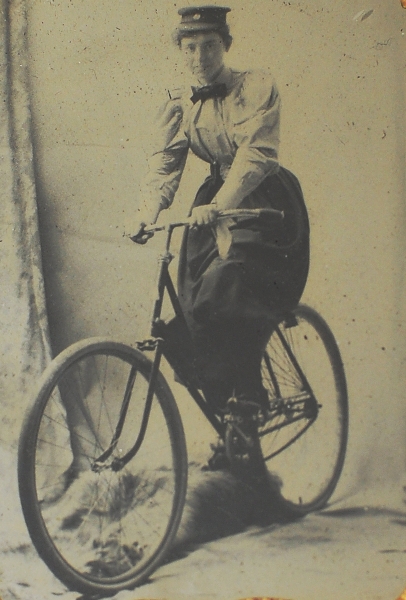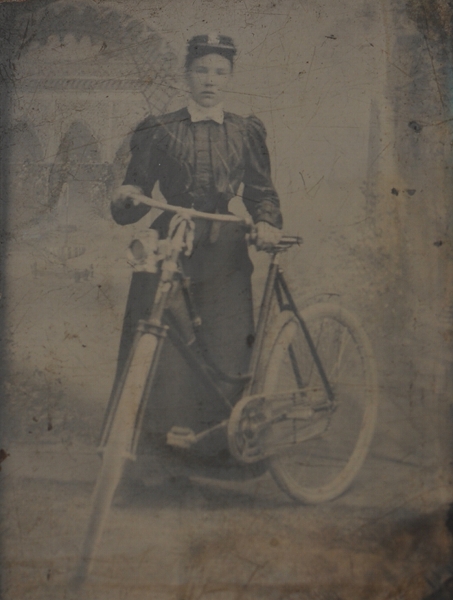Bicycle Portraits in Ambrotype and Tintype
I've been helping a Lovely Bicycle reader with the process of ordering a custom bike, and he sent me something rather wonderful as a Thank You gift.
It's a beautiful little antique case, about 4x3", with the tiniest, delicate latch closure. And inside of it, there is this:
An ambrotype portrait of a young lady on her bicycle, c.1893-94. The ambrotype is one of the oldest methods of photography, where the image is captured as a positive on glass using a wet plate process. Being on glass, ambrotypes are extremely fragile, which is why they were preserved in these enclosed, padded cases. And even with these careful storage methods, not many of them remain. This is a fine gift indeed, to say the least - especially for one obsessed with both bicycles and photographic processes.
Here is a close-up of the image itself. I cannot remove it from its case, so excuse the murkiness. Notice that it is a mirror image - the drivetrain is on the wrong side. The first commercial freewheel was produced by Sachs in 1898, which means that this lady and others of her era were riding fixed gears. Also, notice the absence of fenders, but the presence of dress guards - at least her muddy skirt would not get stuck in the spokes? Otherwise, the bicycle is a fairly classic lady's Roadster (and apropos the earlier gender discussion - yes, these were made specifically for ladies).
The encased ambrotype came in a set with a free-standing tintype - another positive photographic process, this one created on a sheet of blackened iron. Just amazing. Again, there is the mirror image effect. The bicycle here is similar, but with a fancier chaincase and with a headlamp. The person who sent me these pictures believes the women might be bicycle messengers, though it is also possible that the caps represent cycling clubs that were popular at the time. I must admit that I liked the image of them cycling on fixed gear loop frames through the city delivering letters.
With the rising popularity of flickr, many vintage bicycle photos have been getting scanned and placed on the web in the course of the past several years. And it always amazes me to see specifically the portraits of young ladies posing with their bicycles in a proud and stately manner. Getting one's photo taken was a special occasion in the 1890's, something that was only done once in a great while. And opting to pose with a bicycle in one of the few photos that would ever exist of you, seems telling of the relationship the person in the portrait had with their machine. The word ambrotype means "immortal impression" in Greek, and these ladies wanted to be together with their bicycle for eternity. Was it a status symbol, or an object of obsession? Probably both. And I wonder how the digital bike portraits of today will be interpreted 120 years from now - that is, if they remain at all.
It's a beautiful little antique case, about 4x3", with the tiniest, delicate latch closure. And inside of it, there is this:
An ambrotype portrait of a young lady on her bicycle, c.1893-94. The ambrotype is one of the oldest methods of photography, where the image is captured as a positive on glass using a wet plate process. Being on glass, ambrotypes are extremely fragile, which is why they were preserved in these enclosed, padded cases. And even with these careful storage methods, not many of them remain. This is a fine gift indeed, to say the least - especially for one obsessed with both bicycles and photographic processes.
Here is a close-up of the image itself. I cannot remove it from its case, so excuse the murkiness. Notice that it is a mirror image - the drivetrain is on the wrong side. The first commercial freewheel was produced by Sachs in 1898, which means that this lady and others of her era were riding fixed gears. Also, notice the absence of fenders, but the presence of dress guards - at least her muddy skirt would not get stuck in the spokes? Otherwise, the bicycle is a fairly classic lady's Roadster (and apropos the earlier gender discussion - yes, these were made specifically for ladies).
The encased ambrotype came in a set with a free-standing tintype - another positive photographic process, this one created on a sheet of blackened iron. Just amazing. Again, there is the mirror image effect. The bicycle here is similar, but with a fancier chaincase and with a headlamp. The person who sent me these pictures believes the women might be bicycle messengers, though it is also possible that the caps represent cycling clubs that were popular at the time. I must admit that I liked the image of them cycling on fixed gear loop frames through the city delivering letters.
With the rising popularity of flickr, many vintage bicycle photos have been getting scanned and placed on the web in the course of the past several years. And it always amazes me to see specifically the portraits of young ladies posing with their bicycles in a proud and stately manner. Getting one's photo taken was a special occasion in the 1890's, something that was only done once in a great while. And opting to pose with a bicycle in one of the few photos that would ever exist of you, seems telling of the relationship the person in the portrait had with their machine. The word ambrotype means "immortal impression" in Greek, and these ladies wanted to be together with their bicycle for eternity. Was it a status symbol, or an object of obsession? Probably both. And I wonder how the digital bike portraits of today will be interpreted 120 years from now - that is, if they remain at all.






How Cool! Now that will be another thing to collect, old bicycle photos.
ReplyDeleteWhat a great gift! I have a little obsession with old photos of women posing with their bicycles, and a nice little collection to go along with it.
ReplyDeleteThankfully, vintage photos is not one of the things I collect! But these are wonderful to have as a gift.
ReplyDeleteAmy - where do you get them?
Dig those cream tires!
ReplyDeletethey were for sure not messenger riders. the caps are symbols of the different bicycle clubs, every club had its own dresscode.
ReplyDeletethe lamp is an oil lamp. that was standard back then. carbide lamps are usually bigger because they must contain carbide and water...
for the ambrotype - is their a chance that its a different kind of technique? because ambrotype was out in 1890ties...?
Are you sure those bicycles aren't just the photographer's props? The caps and bow ties suggest telegraph employees, in which case the bicycles might represent speed. Not the actual thing, as I doubt that there even were women messengers at the time, but as a symbol.
ReplyDeleteThat is a very thoughtful gift.
ReplyDeleteI really like seeing the bent wood fender and chain guard in the second photo.
Can you imagine the photographer fussing about tire tracks on his (her?) studio floor, and trying to keep the backdrop unmolested by that big 28" tire?
CK
I'm sure you've read some of the histories on feminist advancements the bicycle brought in the late nineteenth century. Among other effects, the bicycle changed fashion (bloomers), gave men and women more equal transportation options (no more side-saddle riding), and even aided the long process towards universal suffrage. Perhaps it's no wonder that so many women chose to have their portraits taken with their bicycles.
ReplyDeleteYou might want to have that appraised and possibly insured. Old ambro-, tin-, and daguerreotypes that feature anything other than a standard portrait can be quite valuable, especially when they still have the original case.
ReplyDelete". . .cycling on fixed gear loop frames through the city delivering letters . . ."
ReplyDeleteIt would be telegrams. They have a "last mile" issue which the bicycle messenger was invented to transit.
My question about the possibility of these women being messengers doesn't revolve around the fact that they're women, however. It's their age. Bicycle messenger was a job for children at the time. They also wore full dress uniforms. I suspect messenger chic.
One not so well known fact about bicycles from that era is that the bicycle had the upper hand over automobiles of the day. It took an concerted effort by car makers of the day to kill the bicycles popularity to allow the automobile to take the lead.
ReplyDeleteAn interesting book on this topic is "Divorce your car" by Katie Alvord.
Those photos are really wonderful but they hide this secret well.
lovely gift. immortal amazon on her fixed-gear roadster. - very sweet. - here is to the www! and to all the connections it creates between individuals, which sometimes are played out in sweet empathic ways...
ReplyDeleteif only for this one has to truly love the time we are living in.
Wow,Thats Awsome!
ReplyDeleteHey,
Are those Schwalbe cream delta cruisers?
:D
One of my goals is to sew an outfit based on what early lady cyclists wore and wear it on the tweed ride. I need an older-looking bike, although for now my 1961 Lady's Raleigh Roadster will do just fine!
ReplyDeleteThat's wonderful gift --- especially for you! Thanks for sharing. Here's a link to a female bike messenger for the Women's Party in 1922:
ReplyDeletehttp://womenshistory.about.com/od/bicycling/ig/Women-and-Bicycling/Woman-on-Bicycle-1922.htm
I usually find them in flea markets, antique shops, junk shops and the like. I also look for photos of spinning wheels, with or without spinners. :)
ReplyDeletemax said...
ReplyDeletethey were for sure not messenger riders. the caps are symbols of the different bicycle clubs, every club had its own dresscode.
That makes more sense.
Also what kfg said about children being messengers.
for the ambrotype - is their a chance that its a different kind of technique? because ambrotype was out in 1890ties...?
The person who sent me these collects them, so I am pretty sure. Also the presentation case is typical of ambrotypes. The year might be off by a few years - but even after tintypes became popular, ambrotypes did not just stop. These things overlap.
Imagine the challenges involved in daily blog posts if you had to rely on the ambrotype method of photography. Wetting plates, focusing that beast of a camera, 30-second exposures. Special steel rests so the subject doesn't move and blur the picture. Rushing to develop the fragile plates with nasty chemicals. Whew!
ReplyDeleteThe effort involved makes the images that much more valuable. And the bikes are pretty cool, too.
aha, ok, thanks for the info, i ve never seen ambrotype in reality, i only posess some tintypes with bicyclists...
ReplyDeleteThe women getting photographed ties in so well with your previous post - plus ça change, plus c'est la même chose.
ReplyDeleteHere are pics showing a woman telegraph messenger. She is neither male nor a child.
ReplyDeletehttp://www.imageenvision.com/free_picture/0003-0702-1619-5216.html
Mike McLennan - exactament : )
ReplyDeleteJim - That is a nice picture; wish it were larger! It is probably equally possible that the women were telegraph messengers and bicycle club members. There are no postal/telegraph bags in the photos, making it difficult to determine for certain.
are these super-tall women?- look at the length of the seat tube, or maybe the cranks are just placed high or the tires are bigger therefore making everything look taller
ReplyDelete"are these super-tall women?"
ReplyDeleteNo.
"look at the length of the seat tube"
They are full size, rather than the shorter bike, longer seat post variety.
"maybe the cranks are just placed high"
Every bike was a "dirt" bike. The Model T Ford also had a high chassis for the same reason.
"the tires are bigger"
That "29ers" roll better over rough surfaces is not a new one.
These ladies don't seem very tall compared to their 28" roadster tyres (much larger than 700c with road tyres). I think the bottom brackets are high. On my Pashley, which shares its geometry with some of the vintage male Roadsters, the chain stays are straight. That, together with 28" affords the highest BB possible with any conventional bike. You sit tall, and it helps a lot when maneuvering through mud and snow.
ReplyDeletePersonally I like the almost-no-seatpost method of fitting a bike; on a loop frame it just looks more elegant to me.
ReplyDeleteWomen's role in the telegraph business during the 19th c. was far greater than is generally known. In fact, their role unfortunately was later suppressed. This article is probably too long but in it there is the statement that one of these women operators started out as a messenger.
ReplyDeletehttp://www.mindspring.com/~tjepsen/civilwar.htm
I didn't know that they used glass as one of the early forms of photography. You learn something new every day. I'm going to have to look into this a little further.
ReplyDeletePortraits
If you owned a bicycle in the 1890s you were a wealthy person and could afford to also have a studio picture made. The outfits were the fashion of the day for women bicyclists.
ReplyDeleteThe article about women in the telegraph business is very interesting.
When I was a messenger 25 years ago I met a guy during a snow who had been a Western Union messenger as a boy. He said that they always had more work during a snow storm. He mentioned using a "miners lantern" which I assume meant a carbide lamp. I think the lamp in the picture above is kerosene because the fuel reservoir on a carbide lamp seems bigger than the one in the photo.
ReplyDeleteVelouria, on my desk are two, of these same type of photocases, pictures of my ancestors. Both of them are what I suspect to be average shape for their age. One has a crushed edge at the hinge and the other has some of the print pulling away from the glass. Your treasure is indeed unique and very lovely, and extra special for the inclusion of a bicycle.
ReplyDeleteI still have my carbide lamp. The reservoir is smaller than the one in the photo.
ReplyDeleteI'm still not the world's biggest fan of batteries, but I keep putting off getting a hub generator because I'm actually reasonably happy with the latest generation of batteries combined with the latest generation of LEDs. I think it's actually hit six of one, half a dozen of the other in terms of which is "best."
But boy did batteries really used to suck hard and a few of us kept the carbide flame burning after most had already put them out.
These pictures are great. In the link Darryl posted, are those handlebars typical of the period? They look like they'd require a pretty aggressive riding position, maybe meaning that lady was just as hard core as more modern messengers. And I like that idea.
ReplyDeleteWhat a great thank you gift!
ReplyDeleteHere's a great website: the Shorpy Historic Photo Archive. I've seen quite a number of pictures of bikes and bike shops here. Lots of good city photos too, from a century ago (give or take).
ReplyDeleteThe site is also somewhat searchable, so you can find the bikes if you want, but you'll probably get hooked and spend days browsing.
http://www.shorpy.com/
apophasis - Those are an early type of drop bars, and yes they are very typical of the period. Women did ride aggressively and participate in races, even in late Victorian times... initially while wearing skirts and corsets! In the first picture I posted, you can see that the woman is holding the bars close to the stem, which I am guessing she did to adopt an aggressive position indicative of how she actually rides the bike.
ReplyDeleteThose photos are too cool! I'm fascinated by the thought of women dragged their bikes to rare portrait opportunities.
ReplyDeleteThere's a document on the Vintage Trek site, advice to dealers on selling bicycles. An interesting read and very relevant to today's blog.
ReplyDeleteHere's the link: http://www.vintage-trek.com/Trekpromoa.htm
...or go to the bochures page and click on "Dealer Information for Trek Bicycles 1989"
"Retail selling tips" is on page 1.
I love those photos!
ReplyDeleteI find it interesting that bicycling and photography developed (Does anyone still get that pun in the digital age?) at roughly the same time in history.
Bicycles and photography seem to go together even now!
ReplyDeleteI think anyone interested in antique photography and wonders of the past would like shorpy.com
ReplyDeletehttp://www.shorpy.com/node/9414
I'm a children's book illustrator and writer. One of my books is a true story about a boy in 1908 who built his own flying bicycle! I always imagined it would be amazing to go flying over rooftops and chimney tops on a flying bicycle.
The book is 'Cromwell Dixon's Sky-Cycle'... from G.P. Putnams books.
http://cromwelldixonsskycycle.com/
I suppose that if there were such a flying bicycle, the model might be the '1908 Cromwell Dixon Flyer' !
Your blog is fabulous... I'm looking to buy a new bicycle and reading all the posts and comments has been very helpful! Thanks!
lol!